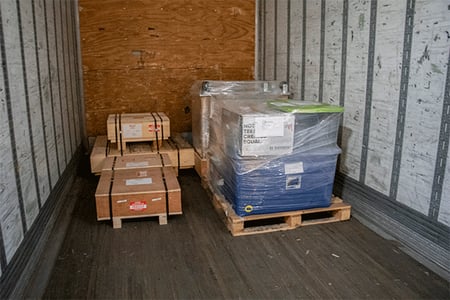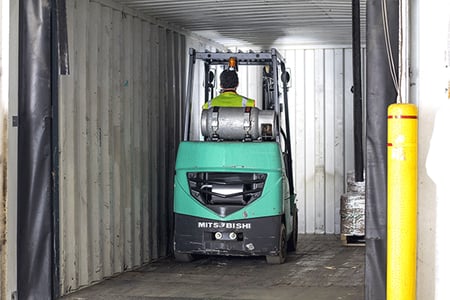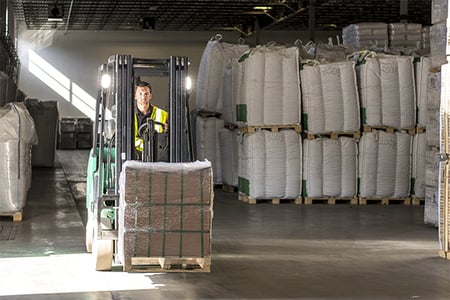
Here at ATS, we’ve been consistently serving the LTL industry for more than three decades. Even before that, our founder, Harold Anderson, was one of the pioneers in LTL shipping — dating back to the 1950s.
In this blog, we’ll explain what LTL shipping is, what the experience is typically like when working with LTL carriers and help you decide what makes the most sense for your needs.
What is LTL Trucking?
LTL shipping is the transportation of fairly small freight that, on its own, doesn’t fill a full truckload. Generally weighing between 150 and 15,000 pounds per customer, LTL carriers usually combine cargo from several different customers into one trailer to fill it to its capacity.
LTL shipping is a great option if you don’t have enough freight to fill an entire truckload. Keep in mind, it will cost you more for the volume you’re shipping than it would for the same amount of volume if you fill an entire truck.
That’s because the carrier has to do more work to find freight from other shippers to help fill their trucks. If you “do the work for them” by buying a full truckload, you’ll get a better deal.
How Much Does It Cost to Work With LTL Carriers?
If you’re shipping using LTL, you’re likely looking for the lowest rate — and LTL carriers know that. They do their best to cut costs along the way in order to pass the savings on to you.
The cost of LTL shipping relies on the National Motor Freight Classification (NMFC), which creates a standard grouping or grading system similar to what other industries have.
The system uses 18 classes that range from class 50 on the low end to class 500 on the high end. The four factors considered include:
- Density
- Handling
- Stowability
- Liability
When combined, these characteristics establish the commodity’s “transportability.”
As you might expect, the higher the NMFC number, the more expensive it will be to ship. Don’t feel like you need to take on the burden of figuring out your freight’s NMFC on your own. Your transportation provider should have access to a system that allows for accurate classification based on the information you provide to them (more on this later).
Common Problems with LTL Shipping
As is the case with many things, LTL shipping does have a few common problems. These are a few things you might encounter if you ship LTL freight.
Misunderstood Shipping Windows
When you buy products online, you’re probably used to seeing 3 to 5-day shipping or something along those lines. That means you can assume that once the product ships, you can expect it as quickly as three days, but potentially up to five days, pending any issues along the way.
Then there’s Amazon Prime. Have you ever had it take longer than two days to get something you ordered through Prime? It’s the worst! That can happen when using LTL shipping if your carrier or broker doesn’t communicate clearly upfront.
In order to win the bid, many times carriers will say it’s three-day shipping — when in reality it’s 3 to 5-day shipping. That can be a big deal for your business if you’re prepared to receive your inventories before it arrives.
So many things can impact transit time, like weather, road construction, etc.
Incorrect NMFC Codes
As mentioned earlier, the NMFC code is key to LTL shipping. That number almost singlehandedly controls the cost you pay to ship your LTL freight. So it’s incredibly important to get it right up front to know how much you should expect to pay.
If you give some LTL carriers a range of classes it might fit into, they may quote you at the lower class to win the bid and surprise you with a higher price once they see the freight in person. Going up a class or two could run you an extra $200-$300.
Related Content: Partial Truckload (PTL) Vs. Less-Than-Truckload (LTL) Shipping: A Head-To-Head Analysis
Potential Damage During Shipping
LTL freight is handled multiple times during its journey. Other items are loaded into the truck, and your goods are moved to a warehouse and then to another truck.
Properly packaging your LTL freight can help avoid damage. But possibly the most important thing you can do to protect yourself and your freight is to make sure your LTL freight is covered by cargo insurance.
How Can You Avoid Surprises When Shipping LTL Freight?
If you’ve read any of our articles lately, we hope this message is getting ingrained in your head: communicate!
If you give as much information as possible about your freight to your transportation provider, you should get an accurate quote upfront. Take it a step further and include pictures, if possible.
That allows the carrier to enter the correct information into their NMFC system, find the correct class and know exactly what to expect when they show up for pickup. That way, your quote won’t change after the fact.
Be sure to clarify the delivery window too. If it’s vital that your freight arrives in three days, make sure the carrier knows that.
The best bet is to find a transportation partner you can trust and have an open line of communication with them. That way, you’re both on the same page about each other’s expectations and won’t be surprised when your freight — or the final bill — arrives.
Is LTL Shipping Right for You?
If you’re someone who doesn’t ship a high volume of palletized freight at the same time, LTL shipping is likely the best bet for you. If you’re in a heavily-used freight lane, it probably makes even more sense because you won’t have to pay extra to get trucks to stop by your facilities.
In order to avoid any surprise costs, do your best to communicate as clearly as possible right away. And if you find a trusted LTL carrier, let them figure out the NMFC to avoid any hiccups along the way.
Finally, don’t be afraid to ask questions. Make sure you leave your conversation with the LTL carrier knowing exactly how much you can expect to pay and when you can expect your LTL freight to be delivered.

